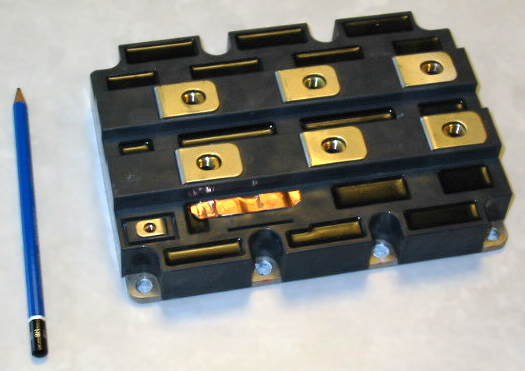jis
Permanent Way Inspector
Staff member
Administator
Moderator
AU Supporting Member
Gathering Team Member
First of all let me assure you there is no question that is stupid. Asking a question is an admirable quality indicating that one is aware of ones limits of knowledge and is willing to learn.I'm gunna sound a bit stupid but, what exactly is "IGBT power"?? I really don't understand what it is.. TIA.
IGBT (Insulated Gate Bipolar Transistor) is a type of electronic device which can switch the flow of electricity off and on at controlled variable rates. This property together with some additional circuitry makes them highly suitable for use in Inverters that are used to produce AC from DC at variable frequency that can be controlled precisely. They can also handle quite large currents (up to ~1,000Amp) at many thousand volts, thus making them suitable for use in power electronics that is used in the drive systems for AC motors in modern electric engines.
In modern engines the power that is drawn from the catenary is first converted to DC at a suitable intermediate voltage, something around 3,000v which drives a common DC link bus. Then all the power consumers feed off of this bus through inverters to deliver the right form of AC for each specific use. This is what makes versatile power inverters that are compact very important, and IGBT is the enabling technology for such. Of course one of the major consumers are the traction motors that provide the motive power for the engine to move a train (and itself).
A typical module capable of handling over a thousand Amps of current at upto 3300V looks like this:

This particular one is a Mitsubishi module. But there are similar modules in the ACS-64 for driving each traction motor.
As it turns out, even though HEP requires a constant frequency AC, the inverter that is used for HEP is essentially the same as a traction inverter but in the HEP mode of operation is controlled differently. The reason this is done is that in case of a traction inverter failure, the HEP one can be used as replacement and conversely in case of a HEP inverter failure a traction inverter can be used as substitute. The latter of course reduces the traction power output of the engine, but that may be tolerable in many cases in order to keep the passengers from freezing or getting a heat stroke.
You can read up more about it starting from the Wiki article on IGBT which can be found at http://en.wikipedia.org/wiki/Insulated-gate_bipolar_transistor.
Hope that helps clarify more than further confuse.
Last edited by a moderator:




